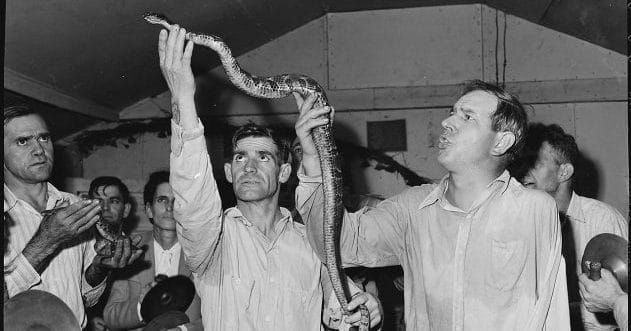Exploring the diverse world of religious practices can often lead us down some truly unexpected paths. While many faiths have unique traditions regarding attire, diet, or worship styles, some take things a step further. Imagine incorporating live, venomous snakes into your church service. It sounds wild, doesn’t it? Yet, for a number of churches, particularly in the Appalachian region of the United States, this is a profound expression of faith.
The act of handling snakes in religious settings isn’t a recent fad; it’s a practice with roots stretching back over a century. Primarily linked to Pentecostal Christianity and other charismatic denominations, these believers take certain biblical passages quite literally – passages suggesting the faithful will be protected from harm when handling serpents. It’s a tradition steeped in danger, devotion, and a history that’s as fascinating as it is controversial. Let’s slither into 10 surprising facts about these snake-handling churches.
10. The Humble Beginnings of Snake Handling
The ritual of handling snakes in church services is most famously tied to specific Protestant groups, particularly in the rural parts of Appalachia. Many trace the modern start of this practice to George Went Hensley, a Tennessee local. The story goes that in 1909, he brought a snake to a church service, setting things in motion. By 1914, Hensley even got a sort of informal nod from the Church of God to continue his serpentine services.
For a while, all seemed to be going smoothly. However, by the late 1920s, the broader church began to distance itself from snake handling. Despite this, the practice had already taken root and spread across Appalachian churches and into other southern areas. Hensley’s fervent approach was too captivating for many to abandon. But some historians suggest he wasn’t the sole originator. They point to a woman named Nancy Younger Kleiniek. According to Pastor Jimmy Morrow, Kleiniek was known for using snakes in revival shows across the Southeast during the 1890s, traveling through Tennessee, Kentucky, and the Carolinas. It’s quite possible Hensley drew inspiration from her work. Regardless of who started it, the practice quickly gained a devoted following.
9. Snake Handling Comes from Several Bible Verses
Churches that practice snake handling often base their beliefs on specific interpretations of Bible verses. They believe these scriptures explicitly instruct believers to handle serpents as a sign of faith. One of the most cited verses is Mark 16:18, which reads, “They shall take up serpents; and if they drink any deadly thing, it shall not hurt them; they shall lay hands on the sick, and they shall recover.”
Another key passage is Luke 10:19: “Behold, I give unto you power to tread on serpents and scorpions, and over all the power of the enemy: and nothing shall by any means hurt you.” It’s clear how these literal interpretations fuel the practice. Some churches also point to the story of the Apostle Paul in Acts 28:1-6, where he is bitten by a venomous snake but suffers no harm. However, not all religious communities agree. Many argue that these verses shouldn’t be taken literally, suggesting “serpents” could be a metaphor for evil or earthly temptations. They might also cite Matthew 4:7, “Thou shalt not tempt the Lord thy God,” viewing snake handling as a dangerous test of God’s will. But for the true believers, their interpretation has guided their worship for over a century, regardless of outside opinions.
8. It Has Always Appealed to Appalachian Believers
While handling snakes has appeared in various cultures globally, in the U.S., it’s most strongly associated with the isolated communities of Appalachia, especially its southern regions. The tradition’s prevalence here is due to a mix of historical beliefs, insulated churches, and a bit of serendipity. As mentioned, George Hensley played a significant role in popularizing snake handling in these Protestant churches, starting in Tennessee. His charismatic personality was a major factor. Had Hensley lived elsewhere, perhaps snake handling would be common in other rural areas too. But the seclusion and tight-knit nature of Appalachian communities provided fertile ground for the practice to spread.
Historically, some churches in the Midwest have also incorporated snake handling, usually when followers from Appalachia brought the tradition with them. It’s uncertain how widespread it is in other areas today. What’s clear is its deep mountain roots. An NPR report from 2013 estimated that around 125 churches still practiced snake handling, mainly in the southernmost Appalachian Mountains across Alabama, Georgia, and the Carolinas. Despite its persistence, many states have outlawed the practice due to safety concerns over handling venomous snakes.
7. Many Snake Handlers Do It in Secret
There’s a significant stigma surrounding snake handling today, leading many churches that engage in the ritual to keep their practices private. A major reason for this secrecy is the legal trouble that can arise from having venomous snakes at religious gatherings. Many jurisdictions have banned snake handling outright, largely due to tragic fatalities that have occurred over the years. For instance, Tennessee passed a law in 1947 after several churchgoers died in a short period. Even if a congregation sees it as a sincere expression of faith, handling snakes can still lead to criminal charges because many states deem it too dangerous.
There’s also a social dimension to the secrecy. In the early 1900s, as snake handling became more common, some religious leaders, even within the Church of God sect of Pentecostalism, gave it their unofficial blessing. However, as the Church of God grew in popularity, the practice came under increased scrutiny. Concerned about public perception and hoping to attract more moderate members, many within the denomination abandoned snake handling. But smaller congregations held onto the tradition, even without the support of larger organizations. For these groups, keeping their practices quiet in certain circles became necessary. With snake handling outlawed in many areas, the churches that continue the tradition generally do so very discreetly.
6. Deadly Snake Bites Are Part of the Gig
The stark reality is that no matter how strong one’s faith, handling venomous snakes can be deadly. This was tragically proven in the case of Kentucky pastor Jamie Coots. He had gained some fame through media coverage of snake handling. However, in 2014, Coots was bitten by a rattlesnake during a service and refused medical treatment. When he later lost consciousness at home, his wife also declined medical help. Sadly, while the Coots family relied on faith, the venom claimed his life.
While some saw Coots’s death as a testament to his faith and submission to God’s will, others were more critical. Fellow pastor Andrew Hamblin, who had been outspoken about snake handling in his own church, reportedly stopped the practice after Coots’s death. “Since Jamie died, I’ve offered a rattler to no one,” he told National Geographic. “I am the shepherd, and I am responsible for what happens in this building.” Increasingly, even within the snake-handling community, there’s a growing acceptance of seeking immediate medical aid after a bite. There’s no religious rule against it. Individuals like “Little Cody” Coots, Jamie’s son, have themselves sought emergency care after being bitten, which in Cody’s case, likely saved his life in 2018. Still, other pastors haven’t been as fortunate in recent years, and death remains a tragic possibility. It seems the community is becoming more aware of the inherent dangers, and hopefully, the importance of preparedness.
5. Snake Handlers Have Deeper Motives
To outsiders, the ritual of snake handling might just look like a dangerous spectacle. Critics often see it as reinforcing negative stereotypes about superstitious or uneducated people, a view that residents of Appalachia and other rural southern areas have faced for a long time. However, this perspective overlooks the deep-seated beliefs of practitioners and the complex reasons why someone would use venomous snakes to glorify God. It’s important to understand that these individuals don’t necessarily see themselves as immune to snake bites. Even as they interpret scriptures to support the practice, they are fully aware of the risks involved.
Despite these dangers, snake-handling believers place immense trust in their faith and God’s will. They understand that handling snakes carries a real potential for harm, even death. Yet, this is a choice they make willingly to express their unwavering devotion. For them, true faith means facing real-world consequences, not just paying lip service to religious ideas. In their view, avoiding such tests would be a rejection of their faith’s complete teachings. Whatever one thinks about snake handlers, they certainly commit fully to their beliefs, willingly testing God’s glory, however impractical or unwise it may seem to others.
4. The Legal Debate Around Snake-Handling Is Tense
Handling snakes, especially venomous ones, might hold cultural or personal meaning for some in the South, but as a practice, it faces ongoing legal challenges due to public safety concerns. While the U.S. Constitution guarantees freedom of speech and religion, lawmakers and officials in many areas have decided that snake handling is an action that needs regulation. They are understandably worried about the risk it poses, not just to the handler but to everyone in the congregation. Over the years, laws restricting snake handling have been enacted in many states, and they remain a contentious issue.
However, this doesn’t mean believers haven’t fought for their rights. Despite claims of religious freedom, legal disputes are common. One notable case occurred in 2013 when Kentucky-based Pastor Andrew Hamblin was charged with unlawfully possessing dangerous wildlife after officials confiscated about 50 venomous snakes from him. Hamblin pleaded not guilty, arguing the state was infringing on his constitutional right to religious freedom. The case eventually ended without a definitive legal resolution, and Hamblin walked free on the charge. While he avoided conviction then, the legality of snake handling will undoubtedly continue to be a contested topic for this close-knit community.
3. Most Encounters Aren’t Actually Deadly… for the Humans
As we’ve seen, stories of pastors and congregants being bitten by snakes are unfortunately not rare. However, it’s also true that many individuals handle these venomous reptiles without suffering any harm. How do they manage these creatures without provoking a defensive bite? The truth is, there’s often a strategy involved. Expert handlers approach snakes calmly and gently. Even pastors who appear to be in a trance-like state often try to maintain controlled movements. This calmness can make the snake less likely to bite. Of course, most experts would advise against handling snakes at all, but these pastors still try to improve their odds.
The conditions in which the snakes are kept also play a significant role. Better care can lead to less aggressive snakes. However, many experts have noted that snakes used in these ceremonies are often kept in poor environments – unsanitary, overcrowded enclosures with inadequate food and water. Jamie Coots, the pastor who died from a snakebite in 2014, openly admitted his snakes typically survived only a few months in captivity, compared to a decade or more for snakes in well-managed zoos. Paradoxically, the poor health of these snakes might sometimes make their venom less potent or their strikes less effective, though this is a grim silver lining.
2. Sometimes, It Actually Works Out
So, if these snakes are so dangerous, why don’t they bite their handlers every single time? Could divine intervention truly be at play, proving the snake-handling preachers right when they survive encounters? While it’s technically possible for individuals to handle snakes without injury, the practice is strongly discouraged by those outside the community. Regardless of one’s faith or the snake’s condition, being bitten by a venomous animal remains a serious risk. This is something Pastor Coots himself experienced multiple times before his fatal bite.
Yet, there is a perceived success rate in this perilous practice. In the past, Coots and other pastors have shared stories of people who were bitten but recovered without medical intervention or antivenom. This isn’t a guarantee, as Coots’s own fate demonstrated, but some do survive these events. So, what happens to the fortunate individuals who are bitten but don’t die? Some attribute it to their faith and divine protection. Skeptics, however, look for scientific explanations. Herpetologists suggest that snakes used in these ceremonies are often underfed and poorly cared for. As a result, they might not be able to inject a significant amount of venom with a single bite. Even if they do strike, the bite might be relatively weak compared to that of a healthy snake in the wild. Furthermore, experts speculate these snakes might have already expelled much of their venom in previous strikes, making each successive bite less venomous. So, when a bite isn’t fatal, it might not be the miracle it seems, though it’s still not a risk anyone should willingly take.
1. Snake Handling Has a Presence All over the World
The handling of snakes isn’t exclusive to Christianity; it appears in various other religious and spiritual traditions worldwide. Historians have found evidence of it in the ceremonies and artwork of Mesoamerican cultures. It has also been a part of venerating the spirit Damballa in Haitian Vodou. The Pueblo people of the American Southwest had a known shamanic practice of collecting rattlesnakes and dancing with them. For the Yokut tribe of California’s Central Valley, it was a way to demonstrate power; they would encourage snakes to bite people, and surviving the bite was seen as a sign of strong spiritual tendencies.
Throughout history, many other groups have handled snakes for religious or communal reasons. For instance, the indigenous Chumash community performed a snake dance that helped decide whether to consume snake meat. A 1943 scientific journal article famously described a Hopi tribe custom involving serpents, where they would dance with snakes and sometimes even hold them in their mouths. Some believed they were protected from harm as long as they were morally upright. Others suggested it was due to their understanding of snake behavior, while some anthropologists wondered if they used substances to make the snakes docile. Whatever the reasons, snake handling has been part of many cultures. Though rare, it’s not just a Christian phenomenon, which doesn’t make it any less astonishing or dangerous!
Conclusion
The practice of snake handling in churches is a complex tapestry woven from literal biblical interpretation, deep-seated faith, regional tradition, and inherent danger. While often viewed with bewilderment or criticism from the outside, for its practitioners, it represents an ultimate test of devotion and a direct engagement with the divine. From its origins in early 20th-century Appalachia to the ongoing legal and ethical debates, snake handling remains a potent symbol of a faith that willingly confronts mortality. Understanding this practice requires looking beyond the spectacle to see the conviction and the profound, if perilous, spiritual journey of its followers.
What are your thoughts on snake-handling churches? Have you encountered similar practices in other faiths? Leave your comment below!










